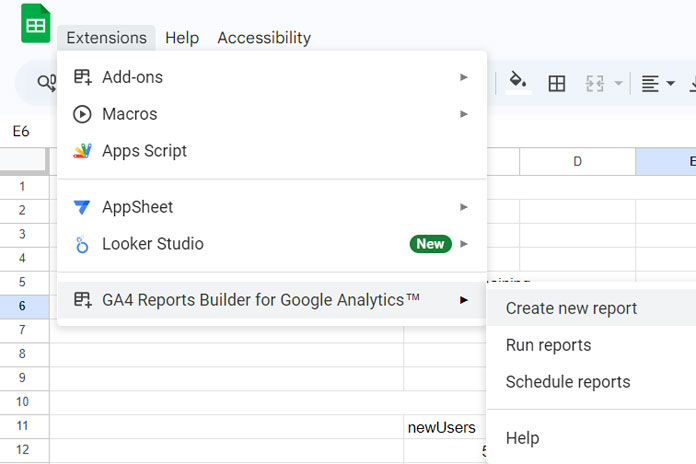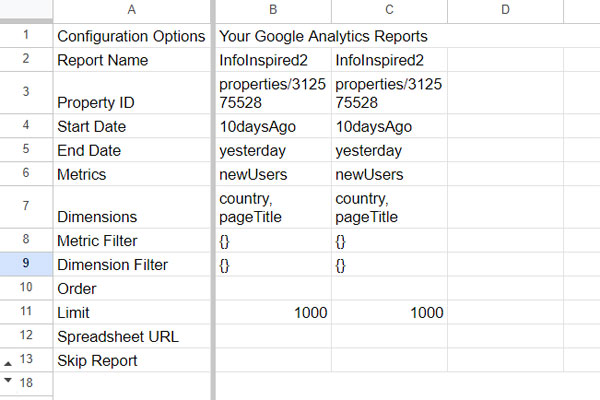Google offers a free and official plugin, GA4 Reports Builder for Google Analytics™, available in the Google Workspace Marketplace. This plugin allows you to easily import Google Analytics 4 (GA4) data into Google Sheets, enabling more advanced data manipulation and visualization.
In this tutorial, you’ll learn how to install the GA4 Reports Builder plugin and import useful data, such as the Pages and Screens Engagement Report.
With Google Analytics, you can view reports, but importing data into Google Sheets offers more flexibility.
Why Import GA4 Data into Google Sheets?
Importing GA4 data into Google Sheets lets you:
- Apply custom filters and sorting.
- Create visualizations like heat maps and custom charts.
- Use functions and pivot tables for more advanced analysis.
- Automate reports and share them with your team.
Step 1: Install the GA4 Reports Builder for Google Analytics Plugin
Follow these steps to install the plugin:
- Open a new Google Sheets file by visiting sheets.new.
- Navigate to the Extensions menu and click Add-ons > Get add-ons.
- In the “Search apps” field, enter Google Analytics and press Enter.
- Find and select GA4 Reports Builder for Google Analytics™.
- Click the Install button and follow the on-screen instructions to complete the installation.
Step 2: Accessing the menu options in the GA4 Reports Builder for Google Analytics
Once the plugin is installed, follow these steps to access it:
- Navigate to the Extensions menu.
- Look for the newly added GA4 Reports Builder for Google Analytics menu item.
- Click it to see options like:
- Create New Report
- Run Reports
- Schedule Reports
- Help
Tip: If you don’t see the new menu item, try reloading the Google Sheets file.

Step 3: Create a Report (Example: Last 10 Days of New Users by Page Title and Country)
To demonstrate how to use the plugin, we’ll create a report that shows the number of new users by page title and country for the last 10 days.
Report Configuration

The most important step in connecting Google Analytics GA4 to Google Sheets is configuring the report. Here’s how:
- Go to Extensions > GA4 Reports Builder for Google Analytics > Create New Report. This will open the Create Report sidebar.
- In the Report Name field, enter a name (e.g., “InfoInspired2”).
- From the Account drop-down, select the Google Analytics account you want to pull data from.
- Select the appropriate Property (the GA4 property for your website).
- In the Start Date field, select NdaysAgo, and enter
10in the field below. This will fetch data from the last 10 days. - In the End Date field, select Yesterday to ensure you’re getting data up to the most recent complete day.
- In the Dimensions drop-down, select Country and PageTitle to view data for each individual page on your site, categorized by country name.
- In the Metrics drop-down, select NewUsers to see the number of new users.
- You can leave the Filters section empty unless you want to narrow down the data further (e.g., filtering for specific pages or user demographics).
- Click the Create Report button.

Running the Report
Now that you’ve configured the report, it’s time to generate it:
- Go to Extensions > GA4 Reports Builder for Google Analytics > Run Reports.
- The plugin will create a new tab in your Google Sheet with the name you specified earlier (e.g., “InfoInspired2”), and the report will display data for the last 10 days.

This is how you can easily import new users by page title and country from Google Analytics into Google Sheets.
Step 4: Scheduling Reports
One of the key features of the GA4 Reports Builder is the ability to schedule reports. This feature automates the process of running reports at regular intervals, so you don’t need to manually run them every time you want updated data.
How to Schedule Reports
- Go to Extensions > GA4 Reports Builder for Google Analytics > Schedule Reports.
- Choose how frequently you’d like the report to run:
- Every Month
- Every Week
- Every Day
- Every Hour
- After selecting the frequency, click Save.
This will ensure that your reports are automatically refreshed with the latest data based on your schedule, saving you time and ensuring up-to-date information for your analysis.
Summary
With the GA4 Reports Builder for Google Analytics plugin, you can seamlessly connect GA4 to Google Sheets, allowing you to create custom reports, automate data fetching, and perform in-depth analysis using Sheets’ advanced functions and visualization tools.
By following this tutorial, you’ve learned how to:
- Install the GA4 Reports Builder plugin.
- Configure and run reports.
- Schedule reports for automated updates.
With these steps, you’re ready to take full advantage of Google Sheets to explore and analyze your GA4 data.





















